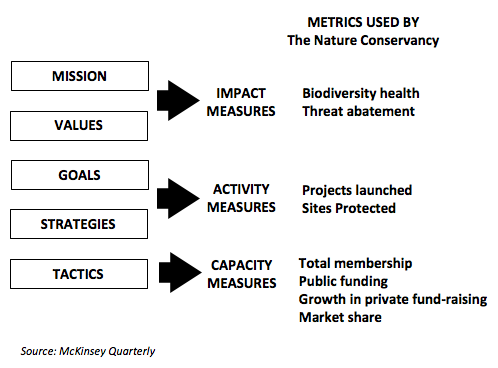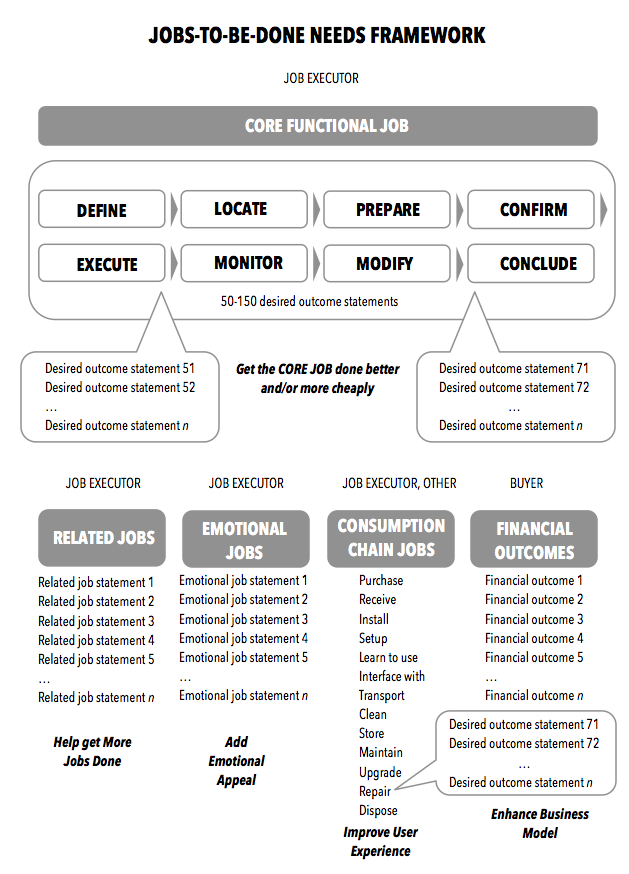While most of us understand that a Non-Profit Organization cannot be “run like a business,” there are several lessons we can learn by applying the Jobs-to-be-Done lens to performance and results.
The late Peter Drucker asked us: What is the Bottom Line when there is no “Bottom Line”? His point is well made:
In a business, there is no financial bottom line. Profit and loss are not enough by themselves to judge performance, but at least they are something concrete. Whether business executives like it or not, profit certainly will be used to measure their performance. When non-profit executives, however, face a risk-taking decision, they must first think through the desired results – before the means of measuring performance and results can be determined. For each non-profit institution, the executive who leads effectively must first answer the question, How is performance for this institution to be defined? (Managing the Non-Profit Organization: Principles and Practices)
In our work, we’ve found that most nonprofit groups track their performance using fundraising metrics. This approach does not help measure the impact of the organization, and worse, it creates a culture that misses the mark when it comes to organizational mission.
Who is the Customer?
Before we apply Jobs-to-be-Done to Non-Profits, let’s answer another one of Drucker’s famous questions: Who is the customer?
A Non-Profit has five customers: three within the company: the recipient of the aid or service, the donor, and the volunteer; and two within: the leadership and the employee.
Unlike traditional business, the Non-Profit must create and operate a “non-profit business model” that meets the needs of all five customers. By applying the Jobs-to-be-Done Needs Assessment Framework to each customer, in turn, the Non-Profit will improve its outcomes and performance on all five fronts. To fail in any one of these areas, is to fail.

What Outcomes Do We Want? The Mission vs. the Job
My take on this is as follows: companies nearly always fail to uncover all or even most of the customer’s needs.
The same applies to Non-Profits.
The problem that Jobs Theory can help solve is defining and measuring the impact of your Non-Profit’s activities, because it focuses on defining recipient needs.
The Nature Conservancy, for example, ties its metrics to its mission:

The question is this: should Non-Profits define their mission based on the Jobs-to-be-Done, or should they pursue a mission based on their ideas?
Idea-driven missions are similar to idea-driven innovations: they fail for similar reasons.
While there is vigorous talk about impact, there is very little understanding the recipient truly needs; there is no agreement of what characteristics a need statement should possess and what the structure, content, and syntax of a need statement should be.
Understanding the Job-to-be-Done changes this entirely. Far too many Non-Profits routinely try to satisfy recipient needs without a clear definition of what a need even is.
Using Jobs-to-be-Done to Measure Impact
What would a Non-Profit’s impact be if it understood the Jobs their recipients were “hiring” them to do?
Let’s examine what Jobs Theory tells us about each of the five customers.
Let’s apply the Jobs-to-be Done Needs Assessment Framework to create a job map:

Recipients
Organizations that prioritize recipient needs will, by default, have a better understanding of what their services and programs need to address. As I point out in Innovation at the Base of the Pyramid: Using Jobs-to-be-Done to Launch Successful Products, the core functional job is the anchor around which all other needs are defined. It is defined first, then the emotional, related and consumption chain jobs are defined relative to the core functional Job. For example, if the core functional job were defined as “access clean water for family”, then we would seek to discover the customer’s emotional and related jobs as they are trying to “access clean water for family.” All other Jobs are in the context executing the core job.
Non-Profits that focus their activities – products, services, and aid – to help get the Job Done are the ones that will have the most impact. Note that even as technology changes, the Job remains the same.
The Gates Foundation is thinking along these lines whem it says that they “avoid a one-size-fits-all approach to evaluation because we want our evaluation efforts to be designed for a specific purpose and for specific intended users.”
Their take on evaluation design, is called fit to purpose, and has three elements:
- It allows for a range of methods, including qualitative and quantitative data collection and analysis, retrospective and prospective designs, experimentation, theory-based evaluation, and systems-based approaches.
- It requires our teams, outside evaluators, and partners to be rigorous about the inferences they make and explicit about the assumptions they use to draw conclusions.
- It requires our teams and our partners to consider evaluation evidence in the context of action so the evaluation efforts produce findings that can be acted on rather than information that is merely nice to know.
What if the Gates Foundation was to pilot a “Jobs-to-be-Done Impact Assessment”?
Donor
Most Non-Profits do a reasonably good job in this area. They employ metrics that include (h/t United Way):
- Program efficiency—This metric clearly indicates program and mission priority. It may be the most important for many charity evaluators, board members, and donors because it shows how funds are used: For overhead, or for making progress.Program efficiency = Total program services expenses ÷ total expenses
- Revenue per member—Many membership-based organizations rely heavily on membership dues and program fees. How much revenue are you generating from your membership?Revenue per member = Member revenue ÷ member count
- Fundraising efficiency—How much do you spend to raise a dollar? This metric shows how efficiently your organization raises funds.Fundraising efficiency = Unrestricted fundraising expenses ÷ total unrestricted contributions raised
Employee and Volunteers
While some Non-Profits create lengthy questionnaires to measure employee and volunteer satisfaction, we know that a primary motivation for both is “to make a difference.” But in the process of making a difference, we have to ask: what are the key employee and volunteer jobs to be done? Are there emotional and social “jobs” that complement the core functional job in their work as volunteers?
Leadership
What jobs are the leaders of the NGO trying to accomplish? Surely they will want to maximize the impact on all stakeholders, beginning with the recipients, then employees and volunteers, and donors or sponsors.
See also: Jobs-to-be-Done for Government
Learn more >>
